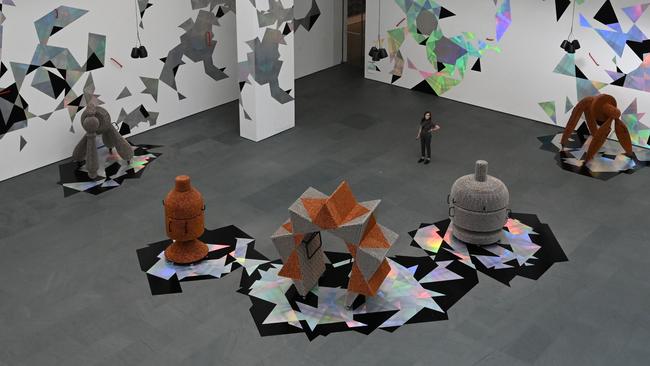Museum of Modern Art swaps grand narrative for broader view
The expanded New York institution’s new approach to displaying its collection is flawed but has its upsides.

The good news about the expanded Museum of Modern Art in New York is that the bad news isn’t as bad as we had been led to believe it would be. Yet the good news isn’t as good as it ought to be, at least with respect to the museum’s handling of its works of “classic modernism”, the period from the 1880s to about 1950.
Advance reports had suggested that when the museum reopened on October 21 we’d be in for a “Pablo who?” situation — a museum where Pablo Picasso and Henri Matisse, the two generative figures of modern art and artists perennially displayed in depth here, had been demoted to bit players.
Fortunately, they’re as well-represented as ever, especially the latter, the beneficiary of a gallery of about a dozen works that show him to better advantage than at any time since before the previous expansion.
Even so, just about everything else has changed. Most significantly, MoMA has abandoned the longstanding chronological, movement-by-movement display that made it to modern art what Florence’s Uffizi Gallery is to Renaissance painting: the indispensable textbook.
Now, what the museum describes as a “general chronological spine” has been supplemented — and to a great degree overwhelmed — by a multitude of thematic mini-exhibitions: for example, Abstraction and Utopia, and Design for Modern Life.
These displays will be cross-disciplinary — painting, photography and architecture together — and occasionally will mix countries, decades and styles. In an effort to give a sense of the whole, roughly one-third of the works on view will be rotated every six months.
The new installation is a collaborative effort of the chief curators of all six departments.
A twofold rationale lies behind this new approach. The first is the museum’s desire to consider modernism as a global phenomenon rather than one limited to Europe and the US; to take greater account of the contributions of African-Americans, women and other groups; and to focus more on byways such as outsider art.
The second — at least this is the museum’s argument — is that “there is no single or complete history of modern and contemporary art”, making the old chronological approach unworkable and irrelevant.

Really? Sure, history is messy. But if any institution has the curatorial firepower to make sense of this one, it’s MoMA. A more plausible explanation is that the history of modern art is now so politically fraught that to attempt a definitive accounting is to court the Furies of one or more aggrieved interest groups. Far safer to rope-a-dope the subject with rotating mash-ups. Then you can tell anyone who complains to come back in six months.
MoMA’s broader view is overdue and welcome.
Latin American modernism is almost uniformly eye-popping. The African-American response to modernism is singular and deserves to be better known. Finally, Anni Albers and Maria Martins are only two members of the distaff side now on the path to overdue recognition.
But that overall concept is marred by instances of special pleading and political tub-thumping, the latter nowhere more egregious than in the gallery containing Picasso’s Les Demoiselles d’Avignon (1907). This is the painting that launched the cubist revolution, seed-ground for many of 20th-century art’s subsequent innovations. As you would expect, it keeps company with later cubist works by Picasso and his comrade Georges Braque. But hanging with it is Faith Ringgold’s American People Series #20: Die (1967), a painting of a race riot.
You don’t know whether to laugh or cry. Let’s be honest: the two are oil and water, despite a wall text arguing otherwise. Ringgold’s inclusion is nothing more than a naked play to the racial and gender politics of the moment — and far from the only such example, sadly. So you’re left to ponder the spectacle of its complete incongruity. The result — and I have to admit this is quite an achievement, albeit unintended — is that Les Demoiselles and the cubist works are upstaged and all but drained of impact.
Such lapses aside, MoMA’s new approach has many upsides. More works are on view, up from about 1500 to nearly 2500, leading to repeated head snaps. Rarely seen objects in its almost 200,000-piece collection will see the light of day. Case in point, a masterwork of the Russian avant-garde returned to view after a decade: Vladimir Baranoff-Rossine’s construction Symphony Number 1 (1913), a semi-abstract figure.
It also means that works too delicate for permanent display, such as Matisse’s The Swimming Pool (1952), arguably the culmination of his climactic, late-career cutouts phase, can be shown more often, if relatively briefly.
What has been lost, though, is grandeur.
Modernism was one of the great intellectual achievements of the 20th century, indeed, of all time, a remarkable fact given the near hopeless odds it faced. Its artists sought nothing less than to square the circle, to express their experience and understanding of the world through private languages — codes, essentially — that were nonetheless publicly accessible. The fact we are still captivated by this work is proof of their success.
But it was hard-won. “It’s impossible!” was a frequent exclamation from Alberto Giacometti as he modelled his slender figures.
With its chronological installations, the old MoMA communicated that. You could start with Vincent van Gogh’s Starry Night (1889) and see art beginning to cut its ties with the 500-year-old tradition of illusionism ushered in by the Renaissance; move from there to semi-abstraction, then full abstraction; finish up with Jackson Pollock’s explosive, absorptive, still wonderfully baffling One: Number 31, 1950 (1950); and say to yourself, “I think I get it now.” You might even have said, “Wow!”
It isn’t a question of either-or but both-and. MoMA could have told its story with a firm chronology punctuated by thematic sidebars. Instead, it opted for a fragmented, patchwork installation in which that sense of historic accomplishment has been lost.
Perhaps we shouldn’t be surprised. Ours is an age sceptical of the “lone genius” idea and of exceptionalism generally. We’re told to regard overarching achievement not as a gift but as a matter of routine, not the product of a vision but of a set number of practice hours.
Which is why, at the end of the day, the new, reincarnated Museum of Modern Art tells us more about the current cultural moment than will all the contemporary art it ever displays or acquires.
The Wall Street Journal



To join the conversation, please log in. Don't have an account? Register
Join the conversation, you are commenting as Logout